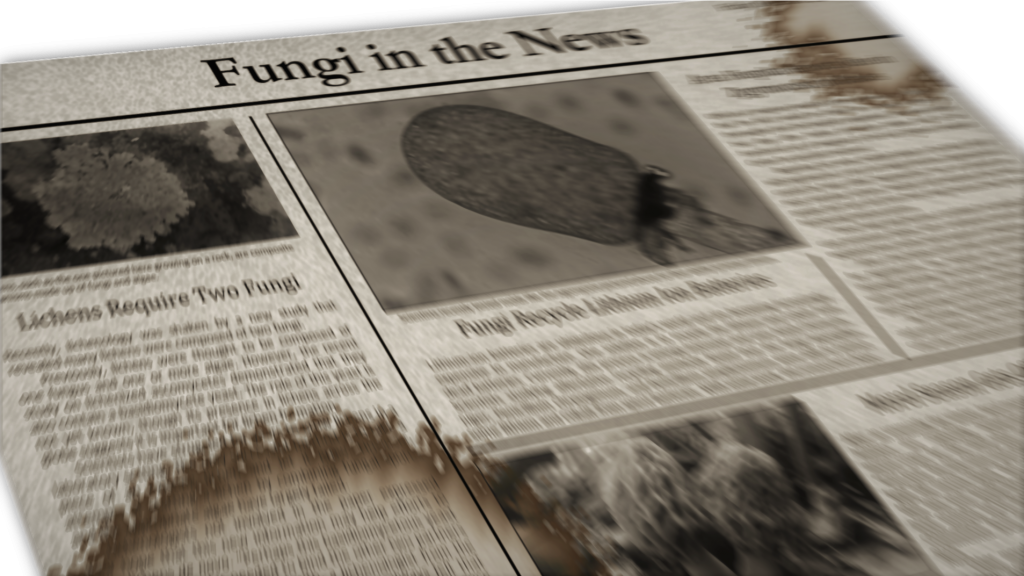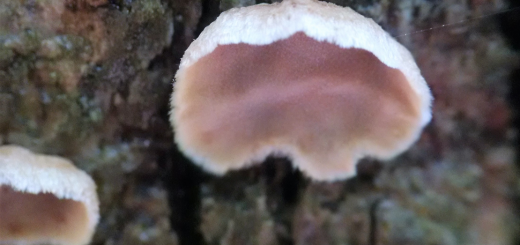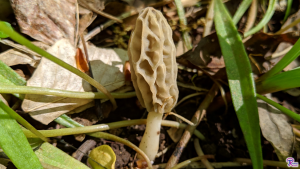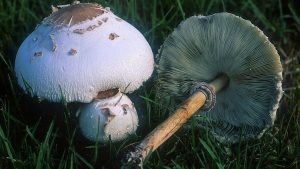2017 Winter News Update
 Fungi appear in the news with surprising frequency. However, many of those stories do not provide any new information. Below is a summary of what we’ve learned about fungi from November 2016 Through February 2017. Read below to learn about: bacteria-fungal interactions, snake fungal disease, psilocybin research, fungal furniture, white-nose syndrome, intelligent slime molds and more! Visit the associated links to get the full story.
Fungi appear in the news with surprising frequency. However, many of those stories do not provide any new information. Below is a summary of what we’ve learned about fungi from November 2016 Through February 2017. Read below to learn about: bacteria-fungal interactions, snake fungal disease, psilocybin research, fungal furniture, white-nose syndrome, intelligent slime molds and more! Visit the associated links to get the full story.
With the growing concern over untrustworthy news sources and the media’s tendency to inaccurately report scientific studies, can these sources be trusted? Yes they can, with a bit of caution. I have checked to make sure all the articles based on scientific papers draw from peer-reviewed journals and that they accurately reflect the content of the papers. For articles not linked to scientific papers, I try to stick to sources with a good track record in reporting on science or to local sources for region-specific information. However, I encourage you to do your own research and decide for yourself whether these sources are trustworthy.
Fungi in Cheese Allow Slow-Growing Bacteria to Dominate
Fungi are important for maintaining the proper balance of bacteria in cheese. Scientists from Tufts University found that normally slow-growing bacteria can dominate the cheese community by using iron provided by the fungus instead of extracting iron themselves. This allows them to grow faster and maintain the correct balance of bacteria in cheese. Read more at: http://www.nature.com/nature/journal/v539/n7627/full/539008a.html
Snake Fungal Disease spreads to Wisconsin, Minnesota
Snake Fungal Disease (SFD, FFF#127) was detected in Wisconsin and Minnesota, suggesting the disease continues to move westward across the country. Researchers do not yet know the impact the disease will have on snake populations in those states. Read more at: http://greatlakesecho.org/2016/11/28/fungus-that-attacks-snakes-spreads-to-wisconsin-minnesota/
Psilocybin Trial for Cancer Patients
Two clinical trials of psilocybin, one from researchers at New York University and the other from Johns Hopkins University, found that psilocybin could potentially be used to treat patients with cancer-related depression. About 80% of the patients involved in the two studies reported decreased anxiety and depression. This effect began immediately and lasted over half a year. All patients also received psychological care throughout that time, so these results cannot be used to support recreational use of the drug. Read more at: https://www.nytimes.com/2016/12/01/health/hallucinogenic-mushrooms-psilocybin-cancer-anxiety-depression.html
Monsanto Releases New Fungus-Coated Seeds
Monsanto, a company that frequently draws ire for its genetically modified crops, has developed a fungus coating for seeds that helps young plants grow. The coating attaches spores of the fungus Penicillium bilaiae to the surface of seeds. When the seeds germinate, the fungi grow along the young roots and help the plant extract nutrients from the soil. This could help farmers reduce fertilizer use. The latest version of the fungal treatment remains viable for two years and can tolerate other chemical treatments, potentially bringing microbial seed treatments from a niche industry into mainstream agriculture. Read more: https://www.bloomberg.com/news/articles/2016-12-05/monsanto-says-next-breakthrough-for-farmers-is-a-friendly-fungus-iwc33v9e
New York Company’s Fungus Furniture
Ecovative, a company based in New York, is expanding its range of fungus-based products to include office chairs and desks. The structural components are made from Ecovative’s toxin-free version of engineered wood while all other components are grown from a combination of agricultural waste and fungal mycelium. The resulting products are biodegradable and quickly break down when left outside. Ecovative already sells its fungus products as packing materials, but hopes that its furniture will help reduce waste and improve indoor air quality even further. Read more at: http://www.cnn.com/2016/09/16/world/ecovative-mushroom-furniture/
Little Brown Bats Develop Disease Resistance
Researchers from the University of New Hampshire and the University of California Santa Cruz discovered that some populations of little brown bats in New York are no longer in decline. Bat populations across the United States have dropped dramatically in recent years because of the disease white-nose syndrome (WNS, FFF#???). Analysis of the population data suggests that some little brown bats have developed resistance to the disease. The mechanism of resistance is not yet known. Read more at: https://www.unh.edu/unhtoday/news/release/2017/01/09/unh-research-some-bats-develop-resistance-devastating-fungal-disease
Virus Can Track Spread of WNS
Scientists from Penn State found that a virus infecting Pseudogymnoascus destructans, the fungus that causes white-nose syndrome (WNS, FFF#???), can be used to track the spread of the disease across North America. P. destructans is essentially genetically identical everywhere in North America, which makes it difficult for researchers to track how the fungus spreads. In the new study, scientists identify a new virus found only in North American P. destructans and suggest it could be used to track the spread of WNS. Because the virus varies genetically by region, scientists can potentially use it to discover how the fungus reaches new areas. Read more at: http://news.psu.edu/story/443207/2016/12/23/research/fungus-infecting-virus-could-help-track-spread-white-nose-syndrome
C. albicans Hides from Immune System
Candida albicans, the yeast that causes thrush and other diseases, modifies its cell structure to evade the immune system. According to research from the University of Aberdeen, C. albicans does this in two steps. First, the fungus detects the presence of lactic acid, which is naturally produced by human cells. Second, it changes the makeup of its cell surface to evade the immune system. Normally, the immune system recognizes molecules on the surface of the fungus and attacks it. However, once C. albicans detects lactic acid, it produces compounds that mask those molecules. Read more at: https://phys.org/news/2016-12-stealth-fungus-thrush-immune-experts.html
Mycelium Aids Bacterial Gene Transfer
A key facet to bacterial adaptation and evolution is the ability to swap genes with one another. This process is called “horizontal gene transfer” and it happens only when bacteria are in close contact. Researchers at the Helmholtz Center for Environmental Research discovered that fungal mycelium increases the rate of horizontal gene transfer among bacteria. Fungal hyphae surround themselves with a thin film of liquid. Bacteria can easily swim through this film, which allows them to access new food sources. This “fungal highway” increases bacterial mobility and improves the chances of two bacteria bumping into one another, thus increasing the frequency of horizontal gene transfer. The researchers suggest this could help create more robust soil communities that might be better equipped to break down harmful compounds such as complex hydrocarbons. Read more at: http://www.ufz.de/index.php?en=36336&webc_pm=53/2016
Slime Molds Learn and Teach
Scientists from France’s National Center for Scientific Research found that slime molds can learn new skills and share those skills with one another. The researchers first taught the slime molds to ignore harmless but bitter compounds placed in front of food. When these slime molds were allowed to fuse with ‘naïve’ ones, the naïve slime molds also began ignoring the bitter compounds. This demonstrates a simple form of learning and teaching that may exist in other organisms as well. Read more at: https://www.washingtonpost.com/news/speaking-of-science/wp/2016/12/30/the-strange-case-of-the-slime-molds-that-can-learn-and-teach-one-another/
Mycorrhizas Allow Trees to Cooperate
This article from CNN is not new news for any mycophile, but it is a good description of mycorrhizas, which is surprising in a major news source: http://www.cnn.com/2017/02/07/world/secret-life-of-trees/
Medical Marijuana Contaminated by Fungi
Researchers from the University of California Davis tested medical marijuana from a variety of sources in northern California and found they were contaminated with bacteria and fungi. This is hardly surprising, since marijuana is dried plant leaves, which naturally harbor microorganisms. For most people, these organisms are harmless. However, the fungi and bacteria can cause serious illness in people with a compromised immune system. In fact, medical marijuana has already been provisionally linked with numerous lung infections and one fatality in immune suppressed patients. The UC Davis researchers recommend that anyone with a weakened immune system should avoid using marijuana. Read more at: http://www.sacbee.com/news/local/health-and-medicine/article131391629.html and http://www.cbsnews.com/news/contaminated-medical-marijuana-pot-believed-to-have-killed-cancer-patient/








![#011: Characteristics of Kingdom Fungi [Archived]](https://www.fungusfactfriday.com/wp-content/themes/hueman/assets/front/img/thumb-small-empty.png)



1 Response
[…] an Echo report about a fungal disease in snakes was carried by something called Fungus Fact Friday. That’s right. Someone with the Mycological Association of Washington, Inc. curates news […]